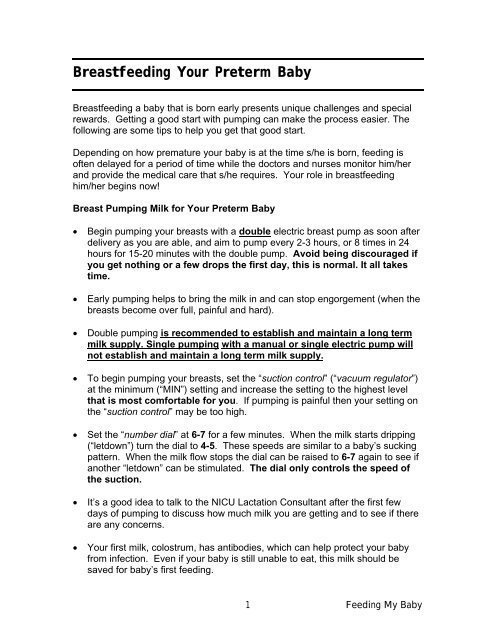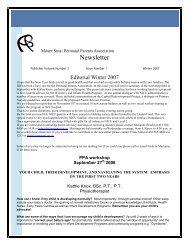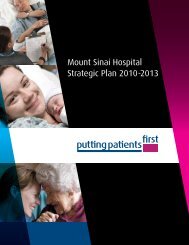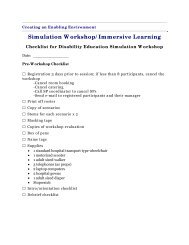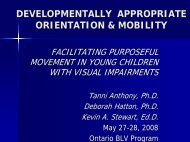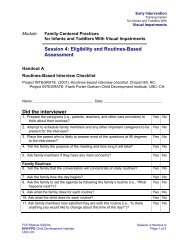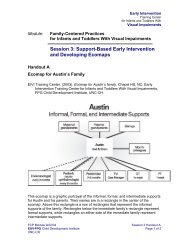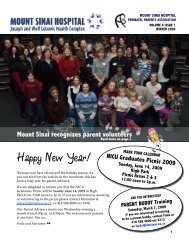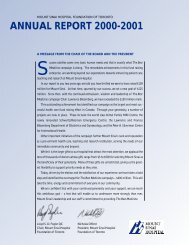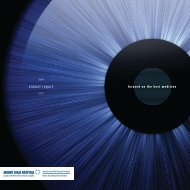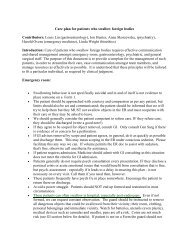Breastfeeding Your Preterm Baby - Mount Sinai Hospital
Breastfeeding Your Preterm Baby - Mount Sinai Hospital
Breastfeeding Your Preterm Baby - Mount Sinai Hospital
Create successful ePaper yourself
Turn your PDF publications into a flip-book with our unique Google optimized e-Paper software.
• Save any milk that you pump and give it to your baby’s nurse. A baby’s firstfeeding can be as little as 1ml (one fifth of a teaspoon!) every 12 hours.• Spend time touching and holding your baby as soon as you are able. Thiswill help to increase your milk supply as well as being a positive experiencefor you and your baby. It’s a good idea to breast pump after you spend timewith your baby.• Using your pump properly will help to ensure a good milk supply. Reviewproper pump settings with the lactation consultant or your nurse. Refer to thepage titled “. ‘Tips for pumping and increasing your milk supply.’• Frequent pumping may be causing your nipples to become tender. Expresssome of your breast milk on to your nipples after pumping and allow to air dryfor several minutes. Be sure the suction control is on minimum, and onlyincrease the pressure if it is comfortable.• Try to stick to your pumping schedule of every 2-3 hours but be flexible withyour pumping times especially during the day. The most important thing isthat you get 8 pumpings in 24 hours. Pump at night and be sure to go nolonger than 4 hours between pumping sessions at night.• When timing pumping sessions, it is similar to breastfeeding sessions,therefore time your pumping session from the beginning of one session to thebeginning of the next session.• Pumping sessions should last 15-20 minutes when you are double pumping.• The team in the NICU/Level II Nursery (Lactation Consultant, nurse, dietician,and doctor) will help you to develop a feeding plan (kangaroo care, nonnutritivesucking, and practice breastfeeding/breastfeeding) for your baby.Which breast pump is best for me?There are a variety of breast pumps available on the market today, so it isimportant to think carefully before you rent or buy a breast pump, as they aredifferent. A good pump can make all the difference. Because your baby was bornearly, long-term frequent pumping is necessary to maintain your milk supply untilyour baby is ready to feed totally from the breast.We suggest that you rent a hospital grade double electric breast pump. For moreinformation, please contact the <strong>Breastfeeding</strong> Centre at 416-586-4543, press 2 orNICU/Level 2 Lactation Consultant at 416-586-4800, ext. 6373.2 Feeding My <strong>Baby</strong>
Is reimbursement for pumps possible?It may be possible for some or all of your pump rental expenses to be covered byyour personal insurance. A form letter that can be signed by your baby’s doctorand submitted to your insurance company is available inside the front cover ofthis binder.How do I use the Medela Lactina pump effectively?The Lactina pump made by Medela is the pump used in the NICU and Level 2nurseries and is the breast pump available for rental in the <strong>Breastfeeding</strong> Centre,7 th Floor. They will show you how to use the breast pump. There are someimportant points to remember for successful pumping. See “ Breast pumping milkfor your preterm baby” Pg. 12.How many times should I pump a day?An ideal pumping schedule should begin within a few hours after yourbaby is born and pumping should be done at least 8 times per day,pumping every 2-3 hours.Here are a few points to remember:• You can be flexible with your pumping schedule. You should pump every 2-3hours in your waking hours and pumping at night is recommended.• It is important to pump a minimum of 7 times/day, but you should increasethis to 8-10 times in 24 hours if your milk supply is decreasing.• Pumping 5-10 minutes is better than missing a pumping session altogether.What is normal milk supply development?Many women are discouraged when they begin pumping because they may getvery little milk, if any, for all their effort. It is important to remember that this isvery normal. It takes several days for the milk supply to be established.It is important that you continue to keep up with your pumping schedule, as thisearly and frequent pumping will help you to develop a good milk supply. Pumpfor the entire length of time, (15 to 20 minutes) even when your milk stops flowingas this will continue to tell your body to produce more milk.Pump every 2-3 hours to make up 8 times in 24 hours. Remember that any milkyou are able to pump is good for your baby! Talk to the NICU LactationConsultant if you have any concerns about how much milk you are getting whenyou pump.3 Feeding My <strong>Baby</strong>
What does breast milk look like?Colostrum is the first milk that you will produce. It is thicker and more yellow incolour than mature breast milk, which is bluish white.What resources are there for me in the hospital?• Lactation Consultant 416-586-4800, ext. 6373• <strong>Your</strong> baby’s nurse• <strong>Breastfeeding</strong> Centre, 7 th Floor, 416-586-4543 press 2• Hours for the <strong>Breastfeeding</strong> Centre: Monday to Friday 10:00 a.m.-1:00 p.m.and 2:00 p.m. – 5:00 p.m. Saturday and Sunday 10:00 a.m-4:00 p.m.Copyright © 2004 <strong>Mount</strong> <strong>Sinai</strong> <strong>Hospital</strong>, Toronto4 Feeding My <strong>Baby</strong>
Welcome to the Breast Pump Room• After your discharge from the hospital, mothers who have infants in NICU orLevel II Nursery are welcome to use our Breast Pump Room. Please ask yourbaby’s nurse for the location of this room. Room 704, code 1254• For your privacy, please ensure the door is closed tightly after you enter andleave the room.• If you have bought a “Pump in Style” please bring it with you when you visit yourbaby and you can use it in the pump room.• If you have rented a “Medela” double electric pump you will need to bring yourown Medela tubing, piston, bottles, flanges, valves and white flaps to usewhen you visit your baby as you can use the breast pump in the pump room.• Please transfer your pumped milk into pink-topped collection bottles. Please askthe nurse caring for your baby for more bottles when you run out. Label thebottle with your baby's name, date and time you pumped.• Soap for cleaning your breast pump kit is available by the sink in this room.• Please also wipe off the hospital pump after use and ensure the room is tidyafter you have finished pumping.• To ensure the privacy only women are allowed in the breast pump room.• A telephone is provided for your convenience for local calls only.• Please contact the NICU/Level 2 or the Lactation Consultant if the breast pumpis not working satisfactorily or there are any other problems with this room. 416-586-4800, ext. 6373.• If you have any questions or concerns about breastfeeding or breastpumping, please contact your baby's nurse or the lactation nurse.Copyright © 2004 <strong>Mount</strong> <strong>Sinai</strong> <strong>Hospital</strong>, Toronto5 Feeding My <strong>Baby</strong>
Handling/Storage/Transportation of Breast MilkHow do I handle expressed breast milk (EBM)?• It is important to wash your hands carefully with soap and water. Rinse and dryyour hands well before expressing and handling your EBM.• Each time you express milk use clean breast pump equipment and sterilecontainers (preferably plastic) for milk collection and storage.• Collect milk in a new container each time you pump your breasts.• Label the container with your baby's first and last name, the date and time ofexpression so that the oldest milk can be used first.• Avoid filling the container to the top. Ask your nurse how much would bebest to put into each container. Leave about 1 cm (1/2 inch) air space to allowmilk to expand during freezing. Make sure the lid is on tight.How do I store my expressed breast milk?Milk can be stored as follows:• EBM should be frozen immediately if you are pumping at home.• EBM can be stored for 24 hours in a refrigerator, the temperature must be 4 o C(35 - 40 o F).• For 2 weeks in a freezer compartment within a single door refrigerator.• Up to 3-4 months in a freezer, which has a separate door from that of therefrigerator (i.e., a 2 door unit)?• Up to 6 months in a deep freezer at 18 o C (0 o F).• Frozen milk can be thawed in the refrigerator or can be set in a pan of lukewarm water. Milk cannot be refrozen. Avoid leaving EBM to thaw at roomtemperature.• Before feeding, shake the milk to mix the cream that has risen to the top.6 Feeding My <strong>Baby</strong>
How do I bring my expressed breast milk to the hospital?• Only bring in a 2-3 day supply of EBM at a time if possible. Be sure to give themilk to your nurse as soon as you get to the NICU. Please check with yourbaby's nurse to see if there is enough milk to last until your next visit.• EBM that you bring in from home should be kept frozen. Suggestions to keep itfrozen during transport include:a. cooler or container with ice cubes around the bottles;b. freezer packs; orc. insulated bag with ice cubes or freezer packs.Any milk that is thawed must be used within 24 hours or discarded.Copyright © 2004 <strong>Mount</strong> <strong>Sinai</strong> <strong>Hospital</strong>, Toronto7 Feeding My <strong>Baby</strong>
Tips for Pumping and Increasing Milk Supply• Before starting to pump you can help your milk to “let down” (begin to flow) byplacing warm wet washcloths over your breasts. After 10 minutes of warmth,gently massage your breasts using your fingertips in circular motion, workingdownwards toward the nipple. After massaging, gently place a breast in bothyour hands and stroke the milk down the ducts, using the base of your hands.Repeat on the other breast. You are now ready to start pumping.• Try to eat a balanced diet and drink for thirst. You don’t need to drink extrafluids to produce more milk. Have a glass of juice or water to sip whilepumping.• At home have a pumping routine. Set up a comfortable area where you canrelax in a well-supported chair. Place a picture of your baby near by or haveone your baby’s toys/blanket beside you to help you think of your baby.• As soon as you can, hold your baby out of the incubator, place your baby’sbody close to your chest, skin to skin. This closeness can lead to increasedmilk production and letdown. Bring your pumping kit to the hospital and usethe pump in the pumping room or at your baby's bedside after holding yourbaby.• When your baby is ready to start breastfeeding set up a feeding time withyour nurse or the Lactation Consultant. Continue to pump your breasts aftereach breastfeeding.8 Feeding My <strong>Baby</strong>
Effective Positioning and LatchingHow do I latch my baby onto my breast?It is very important to help your baby learn to latch on to both the nipple andareola of your breast to encourage effective sucking and to prevent sore nipples.It is difficult for a baby to get milk by taking only the nipple into his/her mouth andsucking.The size of your nipple may sometimes seem too large for your preterm babywhen breastfeeding. With time and growth your baby will be able to latcheffectively.Effective sucking occurs when the nipple and a portion of the areola are inyour baby’s mouth, and your baby’s gums squeeze the milk out to the sinusesand squirt it into the baby’s mouth.The sucking action of your baby’s tongue helps to keep the areola well back inyour baby’s mouth and massages more milk out of the ducts into the mouth. Asyour baby draws some milk out, more flows down to fill the sinuses.If only the nipple is in your baby’s mouth, your baby gets very little milk and youwill feel a pinching sensation on your nipple instead of pulling/tugging. Thepinching will cause your nipple to get sore. A baby who is only latched onto thenipple should be taken off the breast and helped to latch onto both the nipple andthe areola. If you are having difficulty please ask your nurse for assistance.The sucking behaviours of a preterm infant are different than those of a full termbaby. Babies that are less than 36 weeks of age may have a “burst -pause”sucking pattern. They suck continuously for several seconds before pausing torest and may have more rapid breathing in the resting phase.This is normal for the preterm infant. As your baby gets older you will notice thatyour baby is able to suck for longer periods and has shorter rest periods betweensucking.Please note: During the early days of breastfeeding a premature infant, thebaby may lick and nuzzle at the breast before latching on. This is an importantpart of learning to breastfeed. It helps them to remember mother’s taste andsmell.Copyright © 2004 <strong>Mount</strong> <strong>Sinai</strong> <strong>Hospital</strong>, Toronto9 Feeding My <strong>Baby</strong>
What are the best positions for feeding my baby?Make sure you are in a comfortable position before you start to feed your baby.There are two positions that work best for breastfeeding a preterm infant. Theseare the cross cradle hold and the football hold.It is a good idea to try both positions to find out which position is morecomfortable for you and your baby. In either position it is important to provideextra support to your baby’s head and neck. <strong>Preterm</strong> babies often seem to havea” heavy head” and need to be well supported to avoid affecting the airway , thiswill also make breastfeeding easier.Modified Cradle HoldSit in a chair with pillows to support your shoulder and back, or in an armchair withyour feet slightly elevated on a stool. Put a pillow on your hip to support your baby.Hold your baby's head and upper back firmly with the hand opposite of the feedingbreast, and your arm to hold your baby's body close to you.Use your other hand (same side as the breast) to support your breast by cuppingyour breast with your finger and your thumb behind the areola.Compress your breast (like a sandwich) and gently stroke your baby's upper lip withthe nipple.When your baby's mouth opens wide, pull your baby to the breast so s/he can getthe nipple and as much of the areola in his/her mouth as possible. Try to bring yourbaby to you instead of moving yourself toward your baby. You will find this morecomfortable.10 Feeding My <strong>Baby</strong>
The Football HoldIf possible sit in chair with pillows to support your shoulders and back, or inarmchair. Place an additional pillow on the arm of the chair, or on the bed besideyou to rest your arm on.Holding your baby's head firmly in your hand, tuck your baby under your arms sothat his feet are at your back.Use your other hand to support your breast by placing your fingers under yourbreast and your thumb on top of your breast behind the areola.Express a small amount of milk and tickle your baby's upper lip with the nipple.When your baby opens his mouth wide, pull the baby onto the breast and tuck himin closely so that he can get as much of the nipple as possible.These positions give you good control of your baby's head. When positioning yourbaby make sure his arms are held forward.Copyright © 2004 <strong>Mount</strong> <strong>Sinai</strong> <strong>Hospital</strong>, Toronto11 Feeding My <strong>Baby</strong>
Is My <strong>Baby</strong> Getting Enough From the Breast?When placing your baby to your breast, you and the nurse will be watching for nonnutritivesucking versus nutritive sucking.What are the characteristics of non-nutritive sucking (NNS) at thebreast?• no intake of breast milk• rapid, irregular sucking• baby may latch onto the breast, "lick and sniff", suck, and then fall off• this may be repeated several times• full volumes of tube feeding are requiredWhat are the benefits of non-nutritive sucking?• aids in digestion• promotes self-soothing, calmness, longer periods of quiet sleep• provides pleasant experience around mouth to support successful breastfeeding in the future• aids in milk productionWhat are the characteristics of nutritive sucking (swallowing)?• intake of breast milk as demonstrated by swallowing• slower sucking pattern with more regular rhythm• visible and/or audible swallowing movements• bursts of sucks followed by self-regulated pauses• may range from 10 to 45 minutesHow will I know if my baby is taking any milk?You and your baby’s nurse will be watching for the following:• swallowing• the presence and timing of letdown• milk visible at corners of baby's mouth• visible pulling of breast tissue• your feelings of difference in fullness of breasts before and after the feedings• latching ability• organization and strength of infant sucking• infant behaviour after feeding (asleep, won't eat any more, crying)12 Feeding My <strong>Baby</strong>
• weight gain over time (over a week)• wet diapers (6 times a day)How do I know if my baby needs a supplement?The decision of how much to supplement your baby after a breastfeeding session isdetermined by:• the length of time your baby breastfed nutritively• how well your baby is swallowing• how good your milk supply is.Note: <strong>Your</strong> baby may be at your breast for longer than he is sucking nutritively.There will be a transition from full feeds through the nasogastric tube (NG) tube tofull feeds at the breast as your baby grows and learns how to breastfeed.<strong>Your</strong> Nurse, Lactation Consultant and Doctor will help you to develop a feedingplan that will help your baby to breastfeed.Copyright © 2004 <strong>Mount</strong> <strong>Sinai</strong> <strong>Hospital</strong>, Toronto13 Feeding My <strong>Baby</strong>
<strong>Breastfeeding</strong> <strong>Your</strong> <strong>Preterm</strong> <strong>Baby</strong> at HomeHow will I know my baby is getting enough breast milk when I amhome?Premature babies who are getting enough to eat have frequent, wet diapers, paleurine that does not have a strong smell (6-8 in 24 hours), and regular bowelmovements. All babies have different stooling patterns; however the stool shouldbe soft, yellow and seedy looking. <strong>Your</strong> baby will seem content and happy afternursing and will grow steadily.<strong>Your</strong> baby should be fed every 2-3 hours and on cue, (see below) or about 8-12 times a day (24 hours). If your baby is sleepy, you will need to wake yourbaby regularly (at least 8 times in 24 hours) to feed.Remember crying is a late hunger cue.How will I know if My <strong>Baby</strong> is Hungry?Look fort your baby’s hunger cues and watch for:• Rooting• Hand to mouth movements• Sucking movements• Sucking on fingers and hand• Opening of mouth in response to touch (tactile stimulation)• The key is listening to your baby. If she/he gives you hunger cues, startfeeding your baby. If you offer the breast and your baby starts to feed then she/heis hungry.• Be sure to watch closely as your baby feeds, to be sure she/he isswallowing and therefore eating well. You may have to keep stimulating your babyto keep her/him actively sucking and swallowing.• Call the NICU Lactation Consultant (416-586-4800 x6373), if you have anyquestions or if your discharge feeding plan needs to be changed.Do I Still Need to Breast pump after my <strong>Baby</strong> is Discharged?That will depend on your milk supply and how well your baby is feeding. Thisshould be reviewed with the Lactation Consultant before discharge.14 Feeding My <strong>Baby</strong>
Sometimes pumping is needed for comfort if you are making more milk than yourbaby needs, and sometimes pumping is needed to increase milk supply.Remember if you give some of your previously pumped breast milk, orformula, you will need to continue pumping to maintain your milk supply.Keep in mind the supply and demand concept, the more milk you remove, themore you make, and the opposite.What should I do if I am breastfeeding and I am not sure thingsare going well?• Call the <strong>Breastfeeding</strong> Centre, (416-586-4543, press 2) or public health nurseto set up an appointment to assess the breastfeeding, and help you to set up afeeding plan. Sometimes you just need to hear that everything is going well.• Be sure to take your baby to your family doctor for regular visits and weightchecksWhat should I do if I am breastfeeding but my baby does not wantto nurse?• Be patient and keep trying.• Be sure your baby is positioned well on your nipple, (refer to section onlatching).• Offer a bottle as a last resort.• Continue to pump. Give this milk to your baby. If your baby nurses for5-10 minutes frequently and your breasts remain full after feedingsessions, please call your doctor or <strong>Breastfeeding</strong> Centre (416-586-4543, press 2) for help.How fast should my baby grow?• Please take your baby to your doctor within the first week afterdischarge from the hospital. This helps your doctor get to know yourbaby. It’s good to plan for regular appointments and weight checks forthe first few weeks home.• <strong>Your</strong> baby should be gaining about 4-8 ounces (120-240 grams) perweek after discharge.• <strong>Your</strong> baby's weight is always checked when you go to the doctor. Askfor your baby's weight. <strong>Your</strong> baby's weight gain is one of the best waysto be sure s/he is getting enough to eat.Copyright © 2004 <strong>Mount</strong> <strong>Sinai</strong> <strong>Hospital</strong>, Toronto15 Feeding My <strong>Baby</strong>
Medication Use and <strong>Breastfeeding</strong> <strong>Your</strong> <strong>Baby</strong>As a new mother you may sometimes need to take medications. You mayalready have a health condition that requires taking medication or you may needan “over the counter” medication to help ease symptoms such as back pain, astuffy nose or a headache.If you are breastfeeding, you may be concerned about the effect that medicationmay have on your baby. This concern is normal. The following information willhelp you make the best choice about medications for you and your baby.What should I do if I am taking medications and I am or I want tobreastfeed?• Always tell your baby’s nurse or doctor if you are taking any medicine and arebreastfeeding.• <strong>Your</strong> doctor, pharmacist and/or lactation consultant can help you make thebest choices.Are medications dangerous/harmful for my breastfeeding baby?• Most medications are OK to take during breastfeeding. There are very fewthat actually cause harm to the nursing baby. Check with your doctor,pharmacist, or Motherisk at 416-813-6780.• If you are taking a medication that is considered unsafe for breastfeeding,there is often another choice of medication in the same class that can beused safely. Ask your pharmacist.• Some medications are OK to take as long as the nursing infant is closelymonitored for signs of side effects.What if the medication gets into the breast milk?• Most medications do pass into breast milk; however the amount of medicationthat is transferred to your nursing baby is usually too low to cause anyharmful effects.• With some medications, you can minimize the amount of drug your baby isexposed to by taking the medication at certain times, for example right afteryou breastfeed your baby. <strong>Your</strong> doctor or pharmacist can help set up afeeding and medication schedule.16 Feeding My <strong>Baby</strong>
Are “over the counter” medications safe while I ambreastfeeding?• Most “over the counter” medications such as laxatives, pain relievers, coughand cold medicines are safe while breastfeeding. However, it’s a good idea tocheck with your doctor, pharmacist or lactation consultant before starting anymedication while breastfeeding.Can I take herbal medicine while I am breastfeeding?• There is very little information about the safety of herbal products duringbreastfeeding. It’s best to avoid these products during the months when youare nursing your baby. Some caffeine free herbal fruit teas are nowconsidered safe. Ask your pharmacist.Is it safe to have alcoholic beverages while I am breastfeeding?• Alcohol passes freely into breast milk. Side effects have been reported in thebaby even after only moderate amounts of alcohol taken by the mother.Occasional use of alcohol, such as wine with dinner, does not mean you haveto stop breastfeeding. However, you should time breastfeeding your baby sothat most of the alcohol is cleared from your breast milk. It generally takestwo to three hours per drink for breast milk to be clear of alcohol. Drinkingbeer will not increase milk supply.Can I smoke while I am breastfeeding?• Avoid cigarette smoking while you are nursing. The nicotine in cigarettespasses into milk and may cause infant colic and decrease your milkproduction. Exposure of children to cigarette smoke before and after birthhas been shown to increase the risk for respiratory illnesses such as lunginfections and asthma and sudden infant death syndrome (SIDS).• <strong>Breastfeeding</strong> mothers are strongly encouraged to stop or to limit theirsmoking. If this is not possible, avoid smoking two to three hours before andduring breastfeeding, and do not smoke while in the same room with theinfant. If you are trying to quit smoking, certain products such as the nicotinepatch or nicotine gum can be used during breastfeeding. Ask you doctor orpharmacist.Is it safe to drink coffee while breastfeeding?• Drinking moderate amounts of coffee (i.e. 1-2 cups per day) duringbreastfeeding is considered safe. <strong>Breastfeeding</strong> mothers need to consider theamount of caffeine they take from all sources. Caffeine is found in many food17 Feeding My <strong>Baby</strong>
sources other than coffee including tea, soft drinks, chocolate and in some“over the counter” and prescription medications. A large caffeine intake (i.e.more than 3 cups of coffee per day) while breastfeeding may lead to the babybecoming jittery, colicky, and constipated. Caffeine may also decrease yourmilk supply.Can I use street drugs while I am breastfeeding?• Illegal street drugs such as marijuana, cocaine, heroin and LSD should beavoided while breastfeeding. Toxic effects have been reported amongbreastfed infants whose mothers abused cocaine. Exposure to marijuanathrough breast milk may delay nerve development of infants. The use ofmethadone as part of the treatment of addiction is OK during breastfeedingbut must be monitored by a doctor.Where can I get more information?• Motherisk Program, The <strong>Hospital</strong> for Sick Children 416-813-6780• Perinatal Pharmacy, <strong>Mount</strong> <strong>Sinai</strong> <strong>Hospital</strong> 416-586-8303• <strong>Breastfeeding</strong> Centre 416-586-4543(option 2)• NICU Lactation Consultant 416-586-4800 x6373, ask your baby’s nurse• <strong>Your</strong> baby’s doctor, your Public health nurse or a lactation consultant.Copyright © 2004 <strong>Mount</strong> <strong>Sinai</strong> <strong>Hospital</strong>, Toronto18 Feeding My <strong>Baby</strong>
Nutrition, <strong>Your</strong> <strong>Baby</strong>, <strong>Breastfeeding</strong> and YouYou truly are eating for two (or more!) – not quite, but almost. When you arebreastfeeding, taking care of yourself and your baby means, getting as much restas possible, drinking to thirst and eating well. Eating a variety of foods, inmoderate amounts, chosen from the four food groups of Canada’s Food Guide isa great place to start. Canada’s Food Guide is also a good place to review thebalance of food’s you usually eat. Whatever your needs, the food groups are aguide that help you get important nutrients.What are the four food groups?• Grain Products• Vegetables and Fruit• Milk Products• Meat and AlternativesI’m so tired and don’t have time to make big meals. How can Istill eat well?• Some examples of quick nutritious foods are: cheese, yoghurt, whole grainbread or crackers, eggs, raw vegetables, fruits, nuts, cold sliced meats,vegetable juices, pasta, rice or legume salads, milkshakes.I have been told to drink a lot of fluids when I breastfeed. Howmuch do I need to drink?• Drink when you are thirsty.• If your urine is pale yellow, you are drinking enough. If your urine is dark witha strong smell and you have hard, dry stools, you need to drink more. Be sureto drink when you are thirsty as these are late signs of needing more fluids.• The best choices of fluids are: water, fruit or vegetable juices, milk, or soupDo I need to take any vitamin or mineral supplements?• If you are eating a well-balanced diet the use of supplements is notnecessary. You may finish your prenatal vitamin/mineral supplements if youwant.What about my weight while I breastfeed?• Avoid dieting while you are breastfeeding. This includes liquid diets andweight loss medication.19 Feeding My <strong>Baby</strong>
• It is normal to lose weight during the first 6 months of breastfeeding. Theaverage rate of weight loss is 0.5 to 1.0 kg, (1-2 lbs.) per month after the firstmonth postpartum.• If you have gained more weight than recommended, losing up to 2 kg. (~ 4.5lbs.) per month is unlikely to affect your volume of milk. Watch for signs thatyour baby’s appetite is not being satisfied – if this happens, you need to eatmore.• If you are losing more than 2 kg. (~ 4.5 lbs) per month after the first monthpostpartum, you need to eat more.I don’t like milk and I’m sure I don’t drink enough. What do I do?Milk is an excellent source of calcium. If you dislike drinking milk choose foodswith milk in other forms or other foods such as:High Sources Medium Sources Low SourcesYoghurt Baked beans Parmesan cheeseCheese Soy, white beans BreadMilkPudding/custard (made Broccoli, kalewith milk)Buttermilk Frozen yoghurt AlmondsSkim milk powder Ice milk Ice creamSalmon with bones Tofu OrangesProcessed cheese slices Feta cheese Chick peasCottage cheeseIs caffeine bad for my baby?• A very small amount of caffeine crosses into breast milk. One to two cups ofcoffee a day is unlikely to cause a problem for you or your baby. Somebabies are sensitive, so if your baby is fussy and wakeful, try cutting back oncaffeine to see if the baby settles.• Caffeine is found in coffee, tea, colas, chocolate and many over the countermedications.I’ve heard that drinking a beer helps you make more breast milk.Is this true?There is no clear evidence to suggest that beer increases your milk supply.Alcohol crosses into breast milk, which is harmful for your baby.20 Feeding My <strong>Baby</strong>
I follow a vegetarian diet. How can I best meet my breastfeedingbaby’s nutritional needs?Follow Canada’s Food Guide, getting protein from meat alternatives. <strong>Your</strong> needswill depend on the type of vegetarian diet you follow. With careful planning,following Canada’s Food Guide, vegetarian diets can meet your nutrition needsduring breastfeeding. If you follow a strict vegetarian or vegan diet, speak toyour doctor and/or dietitian. You will have to choose foods that provide adequateiron and will have to consider a source of vitamin B 12 .Can I eat peanuts or peanut butter while I am breastfeeding?Pregnant/breastfeeding mothers should avoid eating peanuts or peanut butter ifthere is a history of allergy or asthma in either your or the baby’s father’s family,including in your other children.Key Points1. Compare the foods you eat to Canada’s Food Guide.2. Drink when you are thirsty.3. Vitamins are unnessesary if you eat a balanced diet.4. Reduce your intake of caffeine containing foods and beverages.5. Avoid alcohol.6. Avoid dieting and trying to lose weight, too fast.7. Eat many small snacks if you are too tired or have little time to prepare a bigmeal.8. If you are a strict vegetarian, you may need vitamin B 12 supplements. Askyour doctor or dietician.Please speak to the lactation consultant or dietician if you would like moreinformation.Publications Available• “Canada’s Food Guide”, 1992. – Health & Welfare Canada• “Iron” Essential For Good Health, - Beef Information Centre• “Iron” – Beef Information Centre21 Feeding My <strong>Baby</strong>
• “Calcium Calculator”, 1999, - B.C. Dairy Foundation and the Dairy Farmers ofOntario• “Calcium” – Dairy Bureau of Canada, 1990• “Fibre Facts” – 1985, Nutrition Communications, - Kellogg, Canada• “Peanut Allergy” – Committee on Toxicity of Chemicals in Food, ConsumerProducts and The Environment. Department of Health, UK, 2000References• Health and Welfare Canada, Feeding Babies, 1986.• Health and Welfare Canada, Canada’s Food Guide, 1992.• Nutrition during Lactation; Summary, Conclusions and Recommendations,National Academy of Sciences Press, Washington D.C. 1991.• Mohrbacher, N. and Stock, J. (1991). LaLeche League International.• The Breast Feeding Answer Book. LaLeche League International Inc.• Lauwers, J. and Woessner, C. (1990). Counseling the Nursing Mother.• Avery Publishing Group, Inc. New York.Copyright © 2004 <strong>Mount</strong> <strong>Sinai</strong> <strong>Hospital</strong>, Toronto22 Feeding My <strong>Baby</strong>
Resources for <strong>Breastfeeding</strong> Mothers<strong>Breastfeeding</strong>, Renfru, M., Fisher, C., & Arms, S. California, 1990The Complete Book of <strong>Breastfeeding</strong>, Eiger, M., and Olds, S., Workman, NewYork, 1987Nursing <strong>Your</strong> Premature <strong>Baby</strong> Pamphlet, LaLeche League International, Inc.(416) 486-3368The Womanly Art of <strong>Breastfeeding</strong>, Dana, N. and Price, A., Meadowbrook, EganMn., 1987<strong>Breastfeeding</strong> Twins, Triplets and Quadruplets, Keith, D.M., McInnes, S. andKeith, L.G., Centre for Study of Multiple Births and Parents of Multiple BirthsAssociation of Canada, Chicago, 1982<strong>Your</strong> local library has many of these books as well as a wide variety of otherbooks available for loan.WEB Sites you may find helpful• www.breastfeeding.com• www.breastfeedingonline.com (this site includes Dr. Jack Newman’s handouts)• www.lalecheleague.org• www.motherisk.orgWho should I speak to for more information on breastfeeding?23 Feeding My <strong>Baby</strong>
• <strong>Your</strong> Lactation Consultant in the NICU, or your baby's nurse in the hospital• <strong>Mount</strong> <strong>Sinai</strong> <strong>Hospital</strong> Maternal Infant Program/<strong>Breastfeeding</strong> Centre.7 th floor: Monday – Friday 10:00 a.m. - 5:00 p.m. 416-586-4543 (2)Saturday & Sunday 10:00 a.m. - 4:00 p.m.• Mother Risk, <strong>Hospital</strong> For Sick Children 416-813-6780• LaLeche League - 24 hours support 416-483-3368• Public Health Nurses: Toronto, you can arrange for a home visit or find outthe nearest <strong>Breastfeeding</strong> Clinic to you 416-338-7600Lactation Consultants: Association of Southern Ontario 416-223-404024 Feeding My <strong>Baby</strong>


